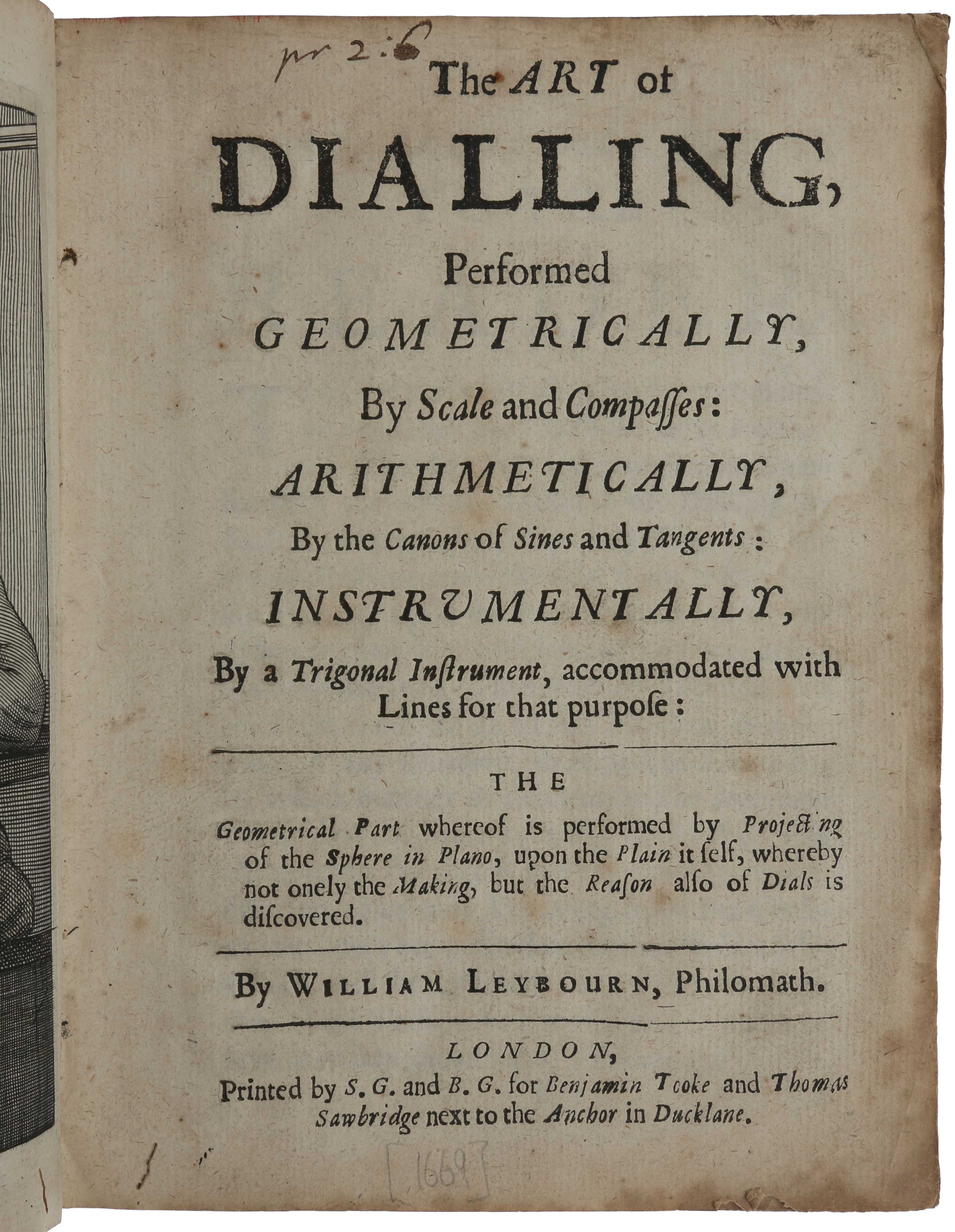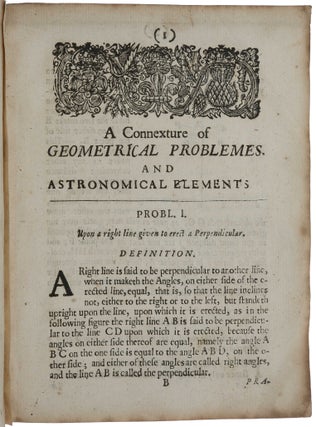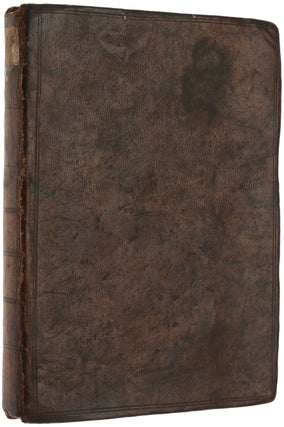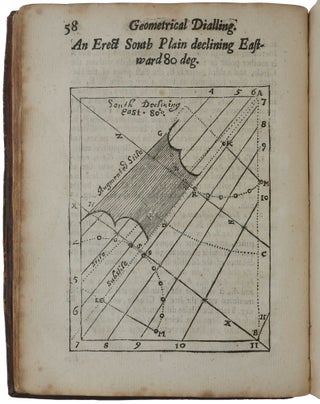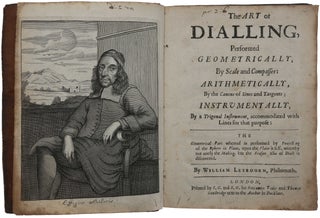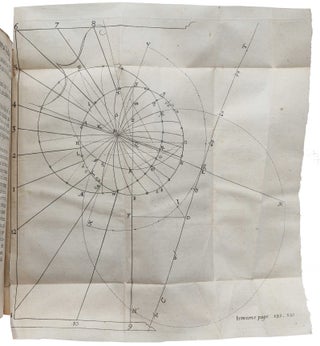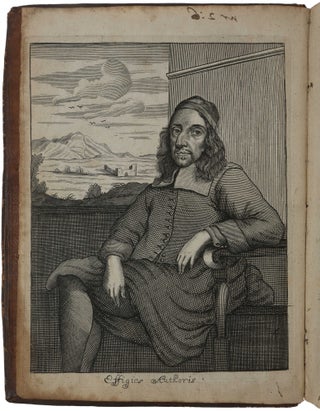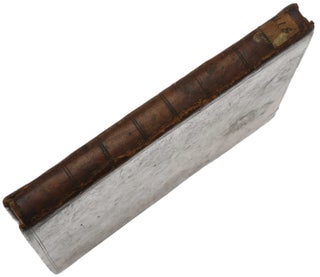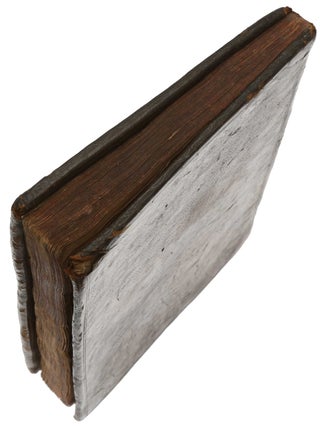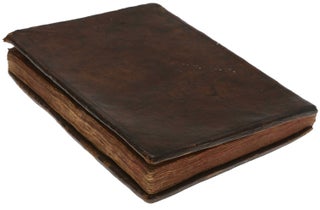The art of dialling performed geometrically by scale and compasses: arithmetically, by the canons of sines and tangents: instrumentally, by a trigonal instrument, accommodated with lines for that purpose; The geometrical part whereof is performed by projecting of the sphere in plano, upon the plain it self, whereby not only the making, but the reason also of dials is discovered.
London: Printed by S[arah]. G[riffin]. and B[ennet]. G[riffin]. for Benjamin Tooke and Thomas Sawbridge, [1669]. First edition, first issue, extremely rare, of the first of Leybourn’s books on the subject. This issue has ‘dialling:’ in line 2 of the title and lacks imprint date; the more common (but still rare) second issue has ‘Dialling,’ and imprint date 1669. This, the Kenney copy, is one of perhaps only two known examples of the first issue, ESTC listing only the BL copy. “In 1669 Leybourn authored The Art of Dialling, a book on the use of sundials and astrolabes in determining the position of vessels at sea. The contemporary expansion of the Royal Navy and Merchant Marines created a significant demand for such manuals, and The Art of Dialling was well written, easy to understand and cheaply produced” (Wikipedia).“The design of sundials represented a steady source of income for independent mathematicians such as William Leybourn. It is quite straightforward to design a standard garden sundial on the horizontal plane with the gnomon angled toward the north celestial pole. It is another matter to design a dial on a wall of a building that is situated at an odd angle to the cardinal compass points. Leybourn was well-known for his books on dialling that treat such arcane subjects as how to create a dial on a ceiling, the sun being reflected from a mirror attached to the windowsill. In this, the first of his several volumes on the subject, he does not consider these very unusual situations but introduces the reader to such fundamental concepts as how to measure the two required angles (reclination and declination) of the surface on which the dial is to be mounted. After a short tutorial on astronomy and the movement of the sun, he covers three different methods of designing dials: geometrically by ruler and compass, arithmetically by means of a table of sines and tangents, and finally by the use of a very simple instrument of his own design. The work concludes with a table of the sun’s declination for each day of the year and a table of the latitudes for each of the major places in Britain. The frontispiece, a portrait of the author, is the same as that later used in his 1672 book Panorganon” (Tomash). Leybourn (1626-1716) enjoyed a fine reputation in his day, both as a fellow (described by John Gadbury as of ‘a facetious, pleasant and cheerful disposition’), and as a mathematician, ranked by William Derham with William Oughtred and Jonas Moore, and some of his textbooks had a life of over a century. “A notable example of the mathematical career that flourished largely away from elite court circles and the universities is that of William Leybourn … Leybourn might with justification be thought one of the most significant London mathematicians of his day. His long life and career paralleled [Christopher] Wren’s closely, though at a distinct social remove” (Edwards, p. 100). No other copies of this first issue located in auction records. “Born in 1626, Leybourn worked originally with his brother Robert as a printer, based at Monkswell Street, Cripplegate. Whilst the Leybourn brothers produced many books for writers involved in technical experimentation and reform, William Leybourn increasingly gave up his printing work to write his own books on mathematics; to teach private pupils whom he boarded at his home in Southall; and to work as a mathematical practitioner, taking part in private and public projects such as the great fire survey, and the surveying of estates forfeited in the Civil War. “Leybourn’s practical work and his writing were clearly highly symbiotic in the maintenance of his career. Leybourn’s books made evident his knowledge and competence in mathematics. They also directly advertised his services. The Line of Proportion, for instance, first published in 1667, offered a straightforward, accessible guide to the use of ‘Gunter’s line’, a logarithmic series designed to help artisans with little mathematics compute areas and volumes mechanically. An unfussy duodecimo volume, it was first published in the immediate aftermath of the great fire and dedicated to the City grandees who oversaw the surveying of the ruins. As well as advertising Leybourn’s employment in this survey, later editions of this simple, practical book were used to tout for further business with a wider clientele. One edition (1673) carries the following notice: ‘If any Gentleman, or other Person, desire to be instructed in any of the Sciences Mathematical, as Arithmetick, Geometry, Astronomy, the Use of the Globes, Trigonometry, Navigation, Surveying of Land, Dialling, or the like; the Author will be ready to attend them at times appointed. Also, If any Person would have his Land, or any Ground for Building Surveyed, or any Edifice of Building Measured, either for the Carpenters, Bricklayers, Plaisterers, Glaziers, Joyners or Masons work, he is ready to perform the same either for Master Builder or workman: … You may hear of him where these Books are to be sold.’ “Self-marketing such as this is utterly characteristic of Leybourn’s long and fertile publishing career. Leybourn published his first mathematical work, a treatise on surveying, in 1650. By 1682 he was able to fund production of a folio edition of his book on Dialling by subscription, expanding a text first published in quarto form in 1669 [offered here], and furnishing it with his portrait. An insider to the seventeenth-century print trade, Leybourn joined other early modern writers beginning to capitalize on the social currency of their knowledge; owning and selling shares in it. Having made a name for himself, Leybourn effectively franchised his name. He contributed prefaces to other writers’ works, and published in many instances to promote instruments made by his associates: an early example of tie-in marketing. He was also cannily sensitive to the different markets for his books. Some, such as The Line of Proportion, are simply and cheaply produced, with the accent on practical use. Cursus Mathematicus, on the other hand, [a] relatively lavish folio production published in 1690 by subscription and costing twenty shillings, addresses itself to the leisured gentry … Leybourn was a pragmatic man, who promoted mathematical science in order to build his own successful career. But what he was selling wasn’t simply practical utility. No less than [John] Dee, Leybourn recognized that the most valuable commodity in a trade in intellectual knowledge was one which somehow blended practical use and profit with the truth and virtue traditionally associated with liberal disinterest” (ibid., pp. 100-102). Subsequent editions appeared in 1681, 1690, and 1700. ESTC R17714 (BL only). Tomash L90 (second issue). Edwards, Writing, Geometry and Space in Seventeenth-Century England and America, 2006.
Small 4to (189 x 146 mm), pp. [viii], 175, [1], with engraved portrait frontispiece of Leybourn and one folding plate. Contemporary calf (a little rubbed). A very good unrestored copy.
Item #4610
Price: $3,500.00

